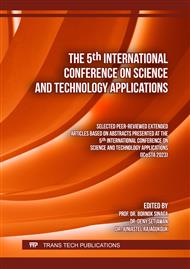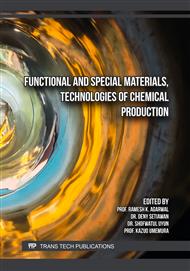[1]
A.G. Godswill, I.V. Somtochukwu, A.O. Ikechukwu, and E.C. Kate, "Health Benefits of Micronutrients (Vitamins and Minerals) and their Associated Deficiency Diseases: A Systematic Review," Int. J. Food Sci., vol. 3, no. 1, p.1–32, 2020.
DOI: 10.47604/ijf.1024
Google Scholar
[2]
A. Akbari, G. Jelodar, S. Nazifi, and J. Sajedianfard, "An Overview of the Characteristics and Function of Vitamin C in Various Tissues: Relying on its Antioxidant Function," Zahedan J. Res. Med. Sci., vol. In Press, no. In Press, 2016.
DOI: 10.17795/zjrms-4037
Google Scholar
[3]
M. Doseděl et al., "Vitamin c—sources, physiological role, kinetics, deficiency, use, toxicity, and determination," Nutrients, vol. 13, no. 2, p.1–36, 2021.
DOI: 10.3390/nu13020615
Google Scholar
[4]
F. Susa and R. Pisano, "Advances in Ascorbic Acid ( Vitamin C ) Manufacturing : Green Extraction Techniques from Natural Sources," no. Vitam. C, 2023.
DOI: 10.3390/pr11113167
Google Scholar
[5]
S. J. Devaki and R. L. Raveendran, "Vitamin C: Sources, Functions, Sensing and Analysis," Vitam. C, no. August, 2017.
DOI: 10.5772/intechopen.70162
Google Scholar
[6]
S. Sumra, N. Humera, A. Asma, S. Muhammad, and R. Shah, "Sensitive and highly selective colorimetric biosensing of vitamin ‑ C and vitamin ‑ B1 by flavoring agent ‑ based silver nanoparticles," JBIC J. Biol. Inorg. Chem., no. 0123456789, 2022.
DOI: 10.1007/s00775-022-01944-5
Google Scholar
[7]
L. Huang, S. Tian, W. Zhao, K. Liu, and J. Guo, "Electrochemical vitamin sensors: A critical review," Talanta, vol. 222, no. August 2020, p.121645, 2021.
DOI: 10.1016/j.talanta.2020.121645
Google Scholar
[8]
E. Mauriz, "Colorimetric Sensors 2 . Distance – Dependent Plasmonic Naked-Eye Colorimetric 3 . Colorimetric Sensors Based on Etching and Growth of Noble Metal Nanoparticles," p.2017–2020, 2014.
DOI: 10.3390/s20216214
Google Scholar
[9]
A. Kumari, V. Vyas, and S. Kumar, "Advances in electrochemical and optical sensing techniques for vitamins detection: a review," ISSS J. Micro Smart Syst., vol. 11, no. 1, p.329–341, 2022.
DOI: 10.1007/s41683-021-00084-3
Google Scholar
[10]
A. Othman, L. Norton, A. S. Finny, and S. Andreescu, "Easy-to-use and inexpensive sensors for assessing the quality and traceability of cosmetic antioxidants," Talanta, vol. 208, p.1–22, 2020.
DOI: 10.1016/j.talanta.2019.120473
Google Scholar
[11]
G. Mushrooms et al., "We are IntechOpen , the world ' s leading publisher of Open Access books Built by scientists , for scientists TOP 1 %," Intech, vol. i, no. 2, p.13, 2022, [Online]. Available: https://doi.org/10.1016/j.jfutfo.2022.09.004%0A https://www.redalyc.org/ pdf/685/68514101.pdf%0A https://doi.org/10.1007/s13668-023-00468-x%0Ahttps://suite.io/ philip-mcintosh/1fjv2v4.
Google Scholar
[12]
M. Sabela, S. Balme, M. Bechelany, J. M. Janot, and K. Bisetty, "A Review of Gold and Silver Nanoparticle-Based Colorimetric Sensing Assays," Adv. Eng. Mater., vol. 19, no. 12, 2017.
DOI: 10.1002/adem.201700270
Google Scholar
[13]
G. Alberti, C. Zanoni, L. R. Magnaghi, and R. Biesuz, "Gold and silver nanoparticle-based colorimetric sensors: New trends and applications," Chemosensors, vol. 9, no. 11, 2021.
DOI: 10.3390/chemosensors9110305
Google Scholar
[14]
R. Roto, H. P. Rasydta, A. Suratman, and N. H. Aprilita, "Effect of reducing agents on physical and chemical properties of silver nanoparticles," Indones. J. Chem., vol. 18, no. 4, p.614–620, 2018.
DOI: 10.22146/ijc.26907
Google Scholar
[15]
D. S. Menamo, D. W. Ayele, and M. T. Ali, "Green synthesis, characterization and antibacterial activity of copper nanoparticles using L-ascorbic acid as a reducing agent," Ethiop. J. Sci. Technol., vol. 10, no. 3, p.209, 2017.
DOI: 10.4314/ejst.v10i3.5
Google Scholar
[16]
P. S. Yerragopu, S. Hiregoudar, U. Nidoni, K. T. Ramappa, A. G. Sreenivas, and S. R. Doddagoudar, "Chemical Synthesis of Silver Nanoparticles Using Tri-sodium Citrate, Stability Study and Their Characterization," Int. Res. J. Pure Appl. Chem., no. March, p.37–50, 2020.
DOI: 10.9734/irjpac/2020/v21i330159
Google Scholar
[17]
D. Acharya, B. Mohanta, S. Deb, and A. K. Sen, "Theoretical prediction of absorbance spectra considering the particle size distribution using Mie theory and their comparison with the experimental UV–Vis spectra of synthesized nanoparticles," Spectrosc. Lett., vol. 51, no. 3, p.139–143, 2018.
DOI: 10.1080/00387010.2018.1442351
Google Scholar



